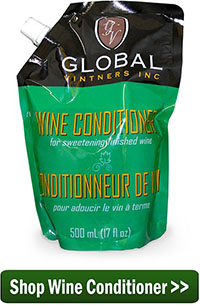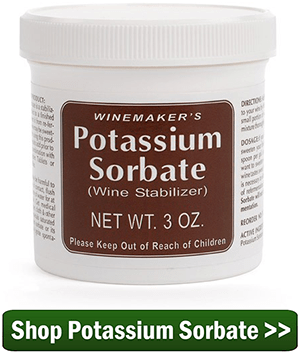 I have a mustang grape wine that has been aging in a carboy. Last night I tried and it has a hydrometer reading of .992. When I tasted the wine, it was too dry for me. How can I sweeten up this wine to a semi sweet?
I have a mustang grape wine that has been aging in a carboy. Last night I tried and it has a hydrometer reading of .992. When I tasted the wine, it was too dry for me. How can I sweeten up this wine to a semi sweet?
John
_____
Hello John,
One of the great things about making your own wine is that you get to drink it the way you want to – even if you want to drink it like our buddy Zach Galifianakis does. For me personally, this is the fun part of making homemade wine. Adjust it until you get the wine just the way you like it. This is something that can’t practically be done unless you are making the wine yourself. This is what makes this hobby so valuable.
 In your case, you are not particularly happy with one of the basic features of the wine: the dryness or sweetness of the wine. You are saying that your homemade wine is too dry for your own personal taste. Fortunately, the solution is very simple. All you need to do is add sugar to the wine until it is at the sweetness you desire – custom made for you!
In your case, you are not particularly happy with one of the basic features of the wine: the dryness or sweetness of the wine. You are saying that your homemade wine is too dry for your own personal taste. Fortunately, the solution is very simple. All you need to do is add sugar to the wine until it is at the sweetness you desire – custom made for you!
It is important to remember that you do not want to adjust the sweetness of a wine until it has completely cleared up and is ready to bottle, so make sure the wine is ready to be bottled before adding the sugar.
At bottling time you can make the wine sweeter tasting. One of the easiest ways of doing this is to use Wine Conditioner. This is basically a sweetener and stabilizer combined together into a syrup. The stabilizer (potassium sorbate) makes sure that your wine does not start fermenting the new sugars while in the wine bottle.
You can also use your own sugar, honey, etc. to sweeten your wine, but you will also need to add potassium sorbate separately to eliminate any  chance of the wine re-fermenting. So, as I think you can start to see, if your homemade wine is too dry, it’s not that big of a deal to fix.
chance of the wine re-fermenting. So, as I think you can start to see, if your homemade wine is too dry, it’s not that big of a deal to fix.
If the sugar you are using is granulated, I would also suggest that you pre-dissolve the sugar into a syrup before adding it to the wine. This will help to eliminate the need for excessive stirring when adding the sugar.
When actually sweetening your wine it is best to sweeten a portion of the batch, first. For example, take a measured sample of the wine – say, one gallon – and add measured amounts of sweetener to it to establish a dosage to your liking. Once the dosage is determined you can then do the same thing to the rest of the wine. This insures that you do not get the entire batch too sweet.
 If you do accidentally add too much sugar to the measured sample, just blend it back into the rest of the batch and start all over with a new gallon sample.
If you do accidentally add too much sugar to the measured sample, just blend it back into the rest of the batch and start all over with a new gallon sample.
We also have an article on our website, Making Sweet Wines, that will have more information about what to do if your homemade wine is too dry. You may want to take a look at it as well.
Happy Wine Making,
Ed Kraus
—–
Ed Kraus is a 3rd generation home brewer/winemaker and has been an owner of E. C. Kraus since 1999. He has been helping individuals make better wine and beer for over 25 years.

I love bitingly-dry wine but the wine kits I’m using are fermenting out at 992/993, not dry enough, please advise.
Miranda, if you want the driest wine you can get, you will need to switch out the yeast that comes with the kit. You want a wine yeast that has a high attenuation. This is the yeasts’ ability to ferment through to the last bit of sugar. I would suggest using the SN9 from Vintner’s Harvest:
Vintner’s Harvest SN9 Wine Yeast
http://www.eckraus.com/vintner-s-harvest-premium-wine-yeast-type-sn9.html
I consider “back sweetening” as one of my great personal accomplishments in wine making! What a new world opens up when you take that additional step. The only thing I do differently than Ed’s comments is to combine two steps: adding the sweetener, and degassing. My thought is that stirring/degassing the wine in one step is a little easier on the final product. Really enjoy your articles, and insight, Ed!
In 5 years I’ve made 25 batches of wine. Final Hydrometer readings anywhere from .982 to .992. None have been TOO dry to enjoy although my preference is slightly semi-sweet. My partner prefers semi-sweet, so some of the batches I have sweetened 1/2 of the batch with regular sugar. Even the batches that were somewhat dry end up pleasantly fruity (better tasting) after 8 months of aging in the bottles, while some of the sweetened taste tooo sweet after aging.
I should have stated that I generally use 10-20% more fruit than what Ed’s recipes call for.